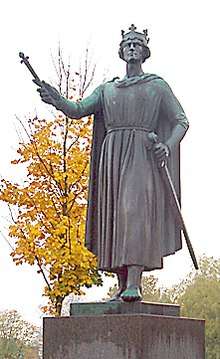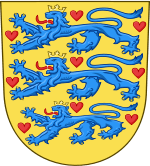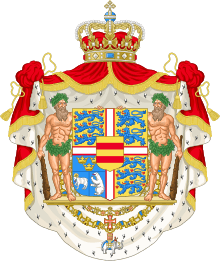Valdemar I of Denmark
Valdemar I of Denmark (14 January 1131 – 12 May 1182), also known as Valdemar the Great (Danish: Valdemar den Store), was King of Denmark from 1146 until his death in 1182. The reign of King Valdemar I saw the rise of Denmark, which reached its zenith under his second son, and successor, King Valdemar II of Denmark. [1]
Biography
He was the son of Canute Lavard, Duke of Schleswig, a chivalrous and popular Danish prince, who was the eldest son of King Eric I of Denmark. Valdemar's father was murdered by Magnus the Strong, days before the birth of Valdemar; his mother, Ingeborg of Kiev, daughter of Mstislav I, Grand Prince of Kiev and Christina Ingesdotter of Sweden, named him after her grandfather, Vladimir Monomakh, Grand Prince of Kiev.
As an heir to the throne, and with his rivals quickly gaining power, he was raised at Ringsted in the court of Danish nobleman Asser Rig of Fjenneslev (ca. 1080-1151). Asser was a member of the Hvide noble family and had been raised together with Valdemar's father Canute Lavard. Valdemar was raised together with Asser's sons, including Absalon (c. 1128–1201) who would become his trusted friend and minister and who serve as Bishop of the Diocese of Roskilde from 1158-92 and Archbishop of Lund from 1178 until his death. [2] [3] [4]
In 1146, when Valdemar was fifteen years old, King Eric III of Denmark abdicated and a civil war erupted. The pretenders to the throne were: Sweyn III Grathe, son of King Eric II of Denmark, the son of King Eric I; and Canute V, son of Magnus the Strong, the son of King Niels of Denmark, brother of King Erik I. Valdemar himself held Jutland, at least Schleswig, as his possession. The civil war lasted the better part of ten years.
In 1157, the three agreed to divide the country in three among themselves. Sweyn hosted a great banquet for Canute, Absalon, and Valdemar, during which he planned to dispose of all of them. Canute was killed, but Absalon and Valdemar escaped. Valdemar returned to Jutland. Sweyn quickly launched an invasion, only to be defeated by Valdemar in the Battle of Grathe Heath on 23 October 1157. He was killed during flight, supposedly by a group of peasants who stumbled upon him as he was fleeing from the battlefield. Valdemar, having outlived all his rival pretenders, became the sole King of Denmark. [5]
In 1158, Absalon was elected Bishop of Roskilde, and King Valdemar I made him his chief friend and advisor. The King reorganized and rebuilt war-torn Denmark. He built Sønderborg Castle as a fortified fortress, constructed on an islet in the Als Strait (Als Sund) that later was connected to Als Island.[6] [7]
At Absalon's instigation, he declared war upon the Wends who were raiding the Danish coasts. They inhabited Pomerania and the island of Rügen in the Baltic Sea. In 1168, the Wendish capital, Arkona, was taken, and the Wends became Christians and subject to Danish suzerainty. Danish influence had reached into Pomerania. In 1175, King Valdemar I built Vordingborg Castle as a defensive fortress and as a base from which to launch raids against the German coast.[8]
Issue
Valdemar married Sophia of Minsk (c. 1141–1198), the daughter of Richeza of Poland, Dowager Queen of Sweden, from her marriage to Volodar of Minsk (Vladimir or Volodar Glebovich of the Rurikids, died 1167), ruling Prince of Minsk. She was the half-sister of King Canute V of Denmark. Valdemar and Sophia had the following children:
- Sophia of Denmark (1159–1208), married Siegfried III, Count of Weimar-Orlamünde.
- King Canute VI of Denmark (1163–1202)
- Maria of Denmark (born c.1165), became a nun at Roskilde (1188).
- Margaret of Denmark (c.1167 - c.1205), became a nun at Roskilde (1188).
- King Valdemar II of Denmark (1170–1241)
- Ingeborg of Denmark (1174–1237), married King Philip II of France.
- Helena of Denmark (c.1176 – 1233), married William, Duke of Brunswick-Lüneburg.
- Richeza of Denmark (c.1178 – 1220), married King Eric X of Sweden.
- Walburgis of Denmark (d. 1177), married Bogusław I, Duke of Pomerania.
His widow Sophia later married Louis III, Landgrave of Thuringia.
Illegitimate with Frille Tove:
- Christopher of Denmark (1150–1173), Valdemar's eldest son, Duke of Jutland (dux Iuciae[9]) ca. 1170–1173.
Ancestry
| Ancestors of Valdemar I of Denmark | ||||||||||||||||||||||||||||||||||||||||||||||||||||||||||||||||||||||||||||||||||||||||||||||||||||||||||||||||||||||||||||||||||||||||||||||||||||||||||||||||||||||||||||||||||||||||||||||||||||||||||||||||||||||||||||||||||||||||||||||||||||||||||||||||||||||||||||||||||||||||||||||||||||||||||||||||||||||||||||||||||||||||||||||||||||||||||||||||||||||||||||||||||||||||||||||||||||||||||||||||||||||||||||||||||||||||||||||||||||||||||||||||||||||||||||||||||||||||||||||||||||||||||||||||||||||||||||||||||||||||||||||||||||||||||||||||||||||||||||||||||||||||||||||||
|---|---|---|---|---|---|---|---|---|---|---|---|---|---|---|---|---|---|---|---|---|---|---|---|---|---|---|---|---|---|---|---|---|---|---|---|---|---|---|---|---|---|---|---|---|---|---|---|---|---|---|---|---|---|---|---|---|---|---|---|---|---|---|---|---|---|---|---|---|---|---|---|---|---|---|---|---|---|---|---|---|---|---|---|---|---|---|---|---|---|---|---|---|---|---|---|---|---|---|---|---|---|---|---|---|---|---|---|---|---|---|---|---|---|---|---|---|---|---|---|---|---|---|---|---|---|---|---|---|---|---|---|---|---|---|---|---|---|---|---|---|---|---|---|---|---|---|---|---|---|---|---|---|---|---|---|---|---|---|---|---|---|---|---|---|---|---|---|---|---|---|---|---|---|---|---|---|---|---|---|---|---|---|---|---|---|---|---|---|---|---|---|---|---|---|---|---|---|---|---|---|---|---|---|---|---|---|---|---|---|---|---|---|---|---|---|---|---|---|---|---|---|---|---|---|---|---|---|---|---|---|---|---|---|---|---|---|---|---|---|---|---|---|---|---|---|---|---|---|---|---|---|---|---|---|---|---|---|---|---|---|---|---|---|---|---|---|---|---|---|---|---|---|---|---|---|---|---|---|---|---|---|---|---|---|---|---|---|---|---|---|---|---|---|---|---|---|---|---|---|---|---|---|---|---|---|---|---|---|---|---|---|---|---|---|---|---|---|---|---|---|---|---|---|---|---|---|---|---|---|---|---|---|---|---|---|---|---|---|---|---|---|---|---|---|---|---|---|---|---|---|---|---|---|---|---|---|---|---|---|---|---|---|---|---|---|---|---|---|---|---|---|---|---|---|---|---|---|---|---|---|---|---|---|---|---|---|---|---|---|---|---|---|---|---|---|---|---|---|---|---|---|---|---|---|---|---|---|---|---|---|---|---|---|---|---|---|---|---|---|---|---|---|---|---|---|---|---|---|---|---|---|---|---|---|---|---|---|---|---|---|---|---|---|---|---|---|---|---|---|---|---|---|---|---|---|---|---|---|---|---|---|---|---|---|---|---|---|---|---|---|---|---|---|---|---|---|---|---|---|---|---|---|---|---|---|---|---|---|---|---|---|---|---|---|---|---|---|---|---|---|---|---|---|---|---|---|---|---|---|---|---|---|---|---|---|---|---|---|---|---|---|---|---|---|---|---|---|---|---|---|---|---|---|---|---|---|---|---|---|---|---|---|---|---|---|---|---|---|---|---|---|---|---|---|---|---|---|---|---|---|---|---|---|---|---|---|---|---|---|---|---|---|---|---|---|---|
| ||||||||||||||||||||||||||||||||||||||||||||||||||||||||||||||||||||||||||||||||||||||||||||||||||||||||||||||||||||||||||||||||||||||||||||||||||||||||||||||||||||||||||||||||||||||||||||||||||||||||||||||||||||||||||||||||||||||||||||||||||||||||||||||||||||||||||||||||||||||||||||||||||||||||||||||||||||||||||||||||||||||||||||||||||||||||||||||||||||||||||||||||||||||||||||||||||||||||||||||||||||||||||||||||||||||||||||||||||||||||||||||||||||||||||||||||||||||||||||||||||||||||||||||||||||||||||||||||||||||||||||||||||||||||||||||||||||||||||||||||||||||||||||||||
Notes
- ↑ "Valdemar Den Store 1131-1182". Danmarks Historien. Retrieved August 1, 2018.
- ↑ "Asser (Rig), 1151". Dansk biografisk Lexikon. Retrieved August 1, 2018.
- ↑ "Asser Rig". Den Store Danske, Gyldendal. Retrieved August 1, 2018.
- ↑ "Absalon". Den Store Danske, Gyldendal. Retrieved August 1, 2018.
- ↑ "Slaget på Grathe Hede 1157". Danmarks Historien. Retrieved August 1, 2018.
- ↑ Otto Norn, Jørgen Paulsen and Jørgen Slettebo, Sønderborg Slot. Historie og bygning, G.E.C. Gad forlag, 1963.
- ↑ "Sønderborg Castle". kongeligeslotte.dk. Retrieved August 1, 2018.
- ↑ About Vordingborg Castle (Museerne.dk)
- ↑ Esben Albrectsen, "Das Abel-Geschlecht und die Schauenburger als Herzöge von Schleswig", Marion Hartwig and Frauke Witte (trls.), in: Die Fürsten des Landes: Herzöge und Grafen von Schleswig, Holstein und Lauenburg [De slevigske hertuger; German], Carsten Porskrog Rasmussen (ed.) on behalf of the Gesellschaft für Schleswig-Holsteinische Geschichte, Neumünster: Wachholtz, 2008, pp. 52–71, here p. 52. ISBN 978-3-529-02606-5
External links
| Wikisource has the text of the 1911 Encyclopædia Britannica article Valdemar I.. |

- Valdemar I of Denmark at Find a Grave
- Valdemar den Store Kings of Denmark, DK
Valdemar the Great Born: 14 January 1131 Died: 12 May 1182 | ||
| Regnal titles | ||
|---|---|---|
| Preceded by Eric Lamb |
King of Denmark 1146–1182 with Sweyn Grathe (1146–1157) & Canute V (1146–1157) |
Succeeded by Canute VI |
| Vacant Title last held by Magnus |
Duke in Southern Jutland titled there: Duke of Denmark ca. 1152–1154 |
Vacant Title next held by Christopher |


